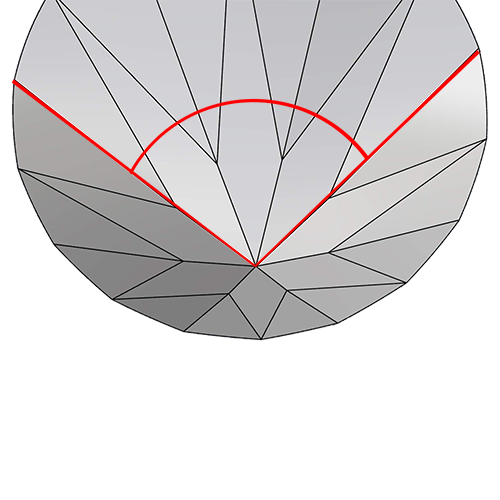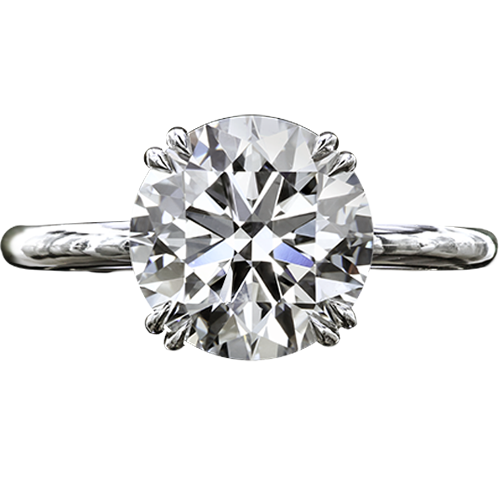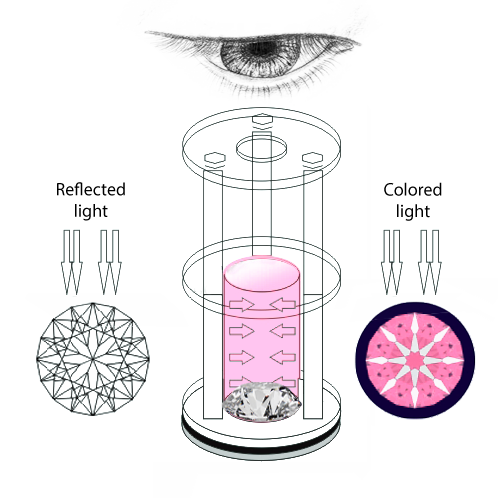- Brilliant Cut Evaluation
- HCA
- ASET
- H & A

The Leon Mege exclusive Brilliance+ Index compares round diamonds by evaluating the data on the GIA certificates. We can predict the diamond’s light performance and brilliance thanks to the proprietary algorithm developed through extensive scientific research. Through the miracle of scientific observations, we created a revolutionary system that calculates the complicated interaction of light with diamond facets and assigns a numeric value.
On a hunt for “Super Ideal”
Evaluated metrics
- Crown angle
- Pavilion angle
- Table
- Total depth
The calculation is based on the stone’s table, height percentage, and angles of the crown and pavilion listed on a GIA diamond certificate. Carat weight has no bearing on the light return and is not required. The girdle thickness does not affect the light return, but an extremely thick or thin girdle requires careful consideration.

The Brilliance+ score is handy for breaking a tie between identical ideal-cut round diamonds. We evaluate the cut grade of any modern round brilliant based on its GIA data. The index is measured on a scale of 0 to 100. Grades within 5 points are nearly identical and do not indicate any advantage over one another. In practice, the maximum grade rarely exceeds 96-97.
The great majority of commercially available round brilliants score below 50. Only a small fraction of round diamonds receive “excellent” -cut, -polish, and -symmetry grades from the GIA. These XXX diamonds score above 50. About 10 percent of GIA XXX diamonds score above 75. In the diamond trade, these stones are called “super-ideal.”

Superior to HCA
Leon Mege Brilliance+ index is superior to the HCA score promoted by Pricescope Cartel. When evaluating a diamond, Brilliance+ is just one step among many we use to reject poor performers. Only GIA-graded round brilliants with XXX grades are eligible for the evaluation. Grades and measurements by gem labs other than the GIA are inconsistent and unreliable. To evaluate a GIA diamond, we ask for a retainer. Results are typically returned the same day.
Brilliance at a bargain
The index is not a reflection of the stone’s beauty. Even a diamond with a low score can be quite beautiful. Moreover, an untrained eye cannot tell the difference between two GIA-certified XXX diamonds, regardless of their score.
The index is designed to highlight the minute differences in the cut and potentially spot a better deal using the Brilliance+ index in conjunction with minor price fluctuations. Brilliance+ is a consumer version of our exclusive 23-point evaluation system used to handpick diamonds for our clients. The index is a simple way to break a tie between several nearly identical stones without becoming a gemologist. It will help to make sense of contradicting information often found online.

Analyzing Light Performance
In diamonds, the reflected light returns as brilliance, the light separated into rainbow colors is returned as fire, and rapid changes from dark to bright light make up scintillation (sometimes called sparkle). A diamond is not a motionless object; it is observed from thousands of angles. Evaluating light return from only one angle will not give a clear picture of its strength.
Different patented gizmos claim the ability to measure the light return from multiple lighting positions, such as BrillianceScope® Analyzer. Unfortunately, none of them come close to a human eye of a professional gemologist.

Pseudoscience runs amok
Holloway Cut Advisor (HCA) is a web-based honeypot collecting personal information under a diamond evaluating system’s guise. The HCA is designed to spy on consumers, and channel leads to affiliated dealers.
HCA is:
- NOT recognized by any gemological lab in the world
- NOT used by professionals
- NOT supported by the scientific community
- NOT subject to a peer review
Hans Christian Andersen described it perfectly: “Two con artists offer to weave the emperor with magnificent cloak invisible to stupid or incompetent people. Once finished, they mimed dressing the emperor, and he set off in a procession. The townsfolk go along with the pretense to avoid being labeled stupid. Until a kid yells: “The emperor has no clothes!” no one was willing to state the obvious.”
Fake Calculator
Like the two swindlers in “The Emperor’s New Clothes,” the HCA plays on people’s pride and intellectual vanity by selling a “diamond score” that no one can see. The imposters, in this case, are the Australian diamond broker and his Russian sidekick. Garry Ian Holloway and Sergey Sivovolenko worked out a scam to substitute the established GIA cut charts with their own cockamamie scheme. One is a self-proclaimed diamond guru; the other is a crackpot operative of notorious Russian tech start-up Octonus Software allegedly working under the cover of the Russian spy agency. The duo acquired the US patent 7,251,619 for “a computer-implemented system for gem evaluation and assessment of a diamond appearance based upon the determined values of attributes contributing to the visual appeal and the established rating value.”


How HCA is misleading
Not surprisingly, the HCA calculator is hosted by Pricescope, the notorious troll farm used by a closely-knit group of brokers and dealers to manipulate public opinion in their own interests and in the interests of the Russian diamond monopoly.
Supposedly HCA can rate a diamond’s “visual appeal” using a proprietary system that has no scientific base. In fact, HCA is neither groundbreaking nor independent or unbiased. All ideal-cut diamonds look exactly the same; a regular person cannot tell them apart. The subtle differences do not make one superior to another. They are equally beautiful. The Holloway Cut Adviser (HCA) is billed as a diamond-cut calculator. It takes a diamond’s metrics, such as total depth, table size, and crown angle. The diamond’s pavilion angle determines 90% of the score.
The calculator also requires a diamond’s weight, measurements, and certificate number. This additional information is collected purely for marketing purposes and is not used in the calculation. Diamonds are scored on a scale from 0 to 10 — the lower the number, the higher the score. Yet, the highest score is not zero but 1.0. Anything less than 1 is also undesirable. The calculator is currently limited to three calculations free of charge; after that, it demands payment.

ASET (for Angular Spectrum Evaluation Technology) is a highly questionable way of assessing a diamond’s “light return.” AGS (American Gemological Society) claims you can distinguish a bad diamond from a good one by staring at the ASET inkblot diagram.
The ASET draws attention away from an inferior AGS color and clarity grading, focusing instead on whimsical light performance represented in cheerful colors on their diagrams.
ASET was invented and performed by the AGS lab. The mind-bending colored stains that would make Hermann Rorschach proud are prominently featured on every AGS diamond certificate. No other labs except AGS perform, use, or recognize this so-called “test.”
Reputable jewelers do not use ASET. A small group of dealers congregating around the fake “consumer” website called Pricescope uses ASET as a marketing tool to sell AGS-graded diamonds. The jewelry trade does not recognize ASET as a legitimate diamond evaluation tool. It’s a scam that AGS perpetrated to undermine GIA supremacy in diamond grading. AGS lost and was recently acquired by the GIA.
The Ring Effect

The difference between good ASET and bad ASET is insignificant compared to other factors, such as the effect of the mounting. The setting alters the stone’s optical properties hundreds of times more than hypothetical gains from using ASET. A stone set into a mounting cancels any ASET advantage of one stone over another.
GIA ideal cut diamond (XXX grade) is enough to guarantee a spectacular-looking diamond. You are better off putting more thoughts into the setting.
Fancy shapes
There is no science behind ASET; it’s a diamond marketing tool. Of course, they will dispute this and tell you that it is a product of decade-long research, but can you trust the lab that routinely over-grades diamonds? I certainly would not.
The ASET was initially intended for “analyzing” round diamonds. Once AGS dealers sensed an opportunity, the racket was also extended to fancy shapes. Using a round ASET cone on a fancy-shaped diamond is as ridiculous as jamming a square peg into a round hole. Three-card Monte con can be played with any deck of cards.

Who needs ASET?

Consumers who fall for the ASET scam are those who rather trust penpals on the web forums more than they trust qualified and experienced jewelers and diamondaires. The third stage of every con job is to encourage the victim’s greed. An AGS jeweler does it by hinting that the ASET test uncovered the diamond’s “hidden value,” which ultimately impairs the cheapskate’s rational judgment. It’s an easy racket – the customers have no clue what they are looking for when they stare at the ASET pictures.
What is the meaning of ASET colors?
When the diamond is lit up from behind, the three colored bands are reflected by the diamond’s facets. You can see the mosaic of colored reflections through the ASET peephole. Depending on their angle, facets reflect the colors of the cone’s wall. According to the AGS, this kaleidoscopic pattern represents a map of a diamond’s “light performance.”
Here is what the colors mean according to AGS pseudoscientific gibberish:
- White is “bad.”
- Green is “sort of bad, but we can twist it around.”
- Red is “good.”
- Blue is “we haven’t decided yet.”

Much like coffee grounds reading, ASET requires charismatic storytelling and vivid imagination. To test a diamond, you need to get the ASET gizmo from AGS or eBay for a fraction of the AGS price.
The cone is colored in a bright green and pink color. The diamond is placed on a clear tray (included) sitting on a light source (your cell phone). Look through the magnifier peephole and see the stone in all its psychedelic glory.
Where does the light go?

All diamonds leak light. There is nothing wrong with it. The light typically dissipates sideways or goes through the stone. Only poorly cut diamonds leak an excess of light, a cause for concern. A diamond with an excellent cut by GIA, by definition, reflects all the light necessary to have exceptional brilliance and fire.
AGS claims that the ASET evaluates the “light performance.” Are you buying a Ferrari or a diamond? There is no performance in diamonds like there is no performance in paintings. It’s either a well-cut gem or junk that is not worth consideration. The subtle differences between ideal-cut diamonds should not be evaluated. They are a beautiful scope of diversity, each triple-X diamond slightly different yet as perfect as any other.

The Japanese obsession with quality and precision resulted in an ideal-cut diamond cut so exactly that the shadows of facets are arranged in curious kaleidoscopic patterns.
The Hearts and Arrows diamonds are rounds cut so precisely that they show a specific pattern through the “Idealscope” gizmo. The pattern resembles arrows radiating from the center, hence the name. Viewed from the pavilion, the pattern resembles eight naked people looking for soap under the round table. Japanese called it “hearts.”
The idea for Idealscope was “borrowed” from Professor Okuda’s Fire Scope™ created in the 1970′s. Japan is the birthplace of the Hearts & Arrows brand, the term patented by Mr. Kinsaku Yamashita. The Central Grading Laboratory (CGL), the largest gem lab in Japan, patented Heart & Cupid trade name used by many Japanese companies to compete with Hearts & Arrows. The original Swords & Shields was replaced by the sugary “Hearts and Arrows.”
All GIA ideal-cut diamonds display symmetric patterns, but Hearts & Arrows is considered a premium and the most recognized brand.
Observing H&A diamonds
A small plastic gizmo sold on eBay or Alibaba is used to observe the pattern of eight pointy arrows. Eight hearts are visible when the stone is flipped upside down.
To use an Ideal Scope, one needs to position the diamond in a slotted disc that comes with it and look through the magnifying glass directly at the diamond.

Definition of H&A diamond

The pavilion’s eight main facets and the sixteen lower halves are responsible for the well-defined H&A arrow pattern. The optimum lower half length should be 75% to 80%, with 76-77% being optimal, all the same length and angle. The ideal range for the Star facets on the crown is 42% to 58%, with 45%-50% being the optimum.
All Ideal cut diamonds with GIA Excellent cut grade show a radiating pattern when viewed with IdealScope. 40.6 to 41-degree pavilion angle guarantees the diamond is Heart and Arrow.
